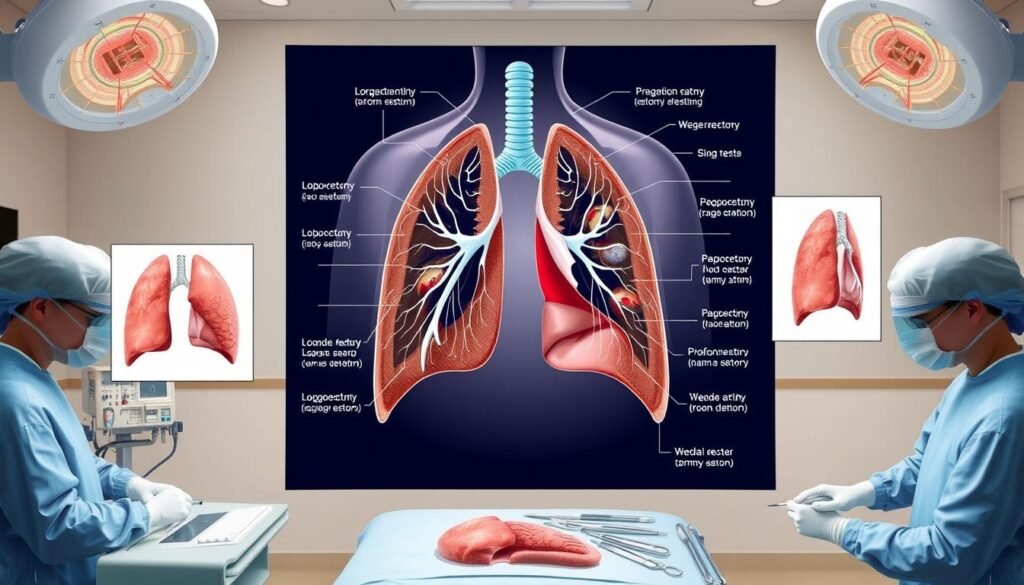Did you know almost 236,000 people in the U.S. are diagnosed with lung cancer each year? Surgery often offers the best chance of beating it, especially in the early stages. It removes the cancerous tissue, boosting success rates and survival times.
It’s key to know how lung cancer surgery is done if you’re facing this challenge. Doctors first do thorough checks, like lung tests and scans. They decide the best surgery method. This could be a traditional cut or a robotic-assisted operation.
Looking at different surgery options can help patients take control of their care. Talking with experienced doctors helps understand what to expect after the operation. This support is crucial for a smooth recovery. For more on lung cancer surgery, read this guide.
Key Takeaways
- Lung cancer surgery is a primary treatment approach for early-stage cases.
- Proper pre-surgical preparation is critical for successful outcomes.
- Several procedures, including thoracotomy and minimally invasive options, are available.
- Surgery can improve lung cancer surgery success rates and quality of life.
- Post-surgery support is essential for recovery and follow-up care.
Understanding Lung Cancer
Lung cancer understanding is key to recognizing its impact. This disease falls into different types, affecting treatment and outcomes. Knowledge of these variants and their signs helps people take control of their health.
Types of Lung Cancer
Lung cancer is mainly divided into two types: non-small cell lung cancer (NSCLC) and small cell lung cancer (SCLC). NSCLC makes up about 85% of all cases. It includes subtypes like:
- Adenocarcinoma
- Squamous cell carcinoma
- Large cell carcinoma
It’s crucial to understand these types. Each one needs a different approach to treatment and carries its own outlook.
Symptoms and Diagnosis
Early spotting of lung cancer symptoms can hugely affect outcomes. Key symptoms are:
- Persistent cough
- Chest pain
- Shortness of breath
Getting a correct lung cancer diagnosis is vital. Doctors often use CT scans and biopsies, or PET scans for confirmation. An early diagnosis means better chances with treatments, possibly improving survival odds.
Surgery for Lung Cancer: When and How It’s Performed
Surgery is key in treating lung cancer. It helps a lot when done early. Patients and families need to understand this option well. Usually, surgery is best when the cancer hasn’t spread much.
Overview of Lung Cancer Surgery
When should surgery happen for lung cancer? It’s best early on, especially for stage I or II. Surgeons remove the tumor and some healthy tissue around it. This ensures no cancer cells are left behind.
There are two surgical options for lung cancer:
- Open surgery: A large cut is made in the chest to reach the lungs.
- Minimally invasive surgery: Methods like VATS need smaller cuts, helping patients recover faster with less pain.
The method chosen depends on the tumor’s size and location and the patient’s health. Doctors run tests before surgery to pick the best method. This helps patients know what to expect in their treatment.
| Surgical Technique | Description | Benefits |
|---|---|---|
| Open Surgery | Large incision made in the chest. | Allows direct access for larger tumors. |
| Minimally Invasive Surgery | Small incisions with the use of cameras. | Shorter recovery time, less pain, fewer complications. |
Lung Cancer Surgery Options
Lung cancer surgery options involve various procedures, each fit for different situations. They depend on the cancer’s type and stage. Knowing these options helps patients and families make smart choices during treatment. Here are the main surgical methods used for lung cancer.
Lobectomy
A lobectomy means taking out one lung lobe. It’s the most common surgery for people with non-small cell lung cancer (NSCLC). It’s best when cancer is in just one lobe. This way, doctors can treat the disease but still save lung function.
Pneumonectomy
A pneumonectomy is when doctors remove a whole lung. It’s for advanced lung cancer stages. If cancer might spread to healthy lung parts, this surgery might be needed. Even though it sounds tough, it’s important for treating lung cancer in some cases.
Sleeve Resection
Sleeve resection is a rarer surgery. It removes part of the airway and a lung segment. It’s an option when the tumor is close to the airway. The goal is to get rid of the tumor and keep as much lung working as possible. It’s chosen in special cases to keep lung power strong.

Benefits of Lung Cancer Surgery
Lung cancer surgery has many benefits for patients. It greatly improves their chances of living longer. By understanding these benefits, patients can make better choices about their treatment. We will look at how surgery can extend life and make it better.
Increased Survival Rates
Having lung cancer surgery can really increase survival rates. This is especially true if the cancer is found early. Studies show that surgery can lead to more than half of patients living at least five years when the tumor is just in one area. Knowing this highlights how crucial early surgery is for a better chance of survival.
Quality of Life Improvements
After lung cancer surgery, many patients feel much better overall. They often have less trouble breathing and can do more physically. People say it gets easier to do daily things. Also, surgery helps lower the chance of the cancer coming back. This gives patients a more hopeful future.

| Benefit | Details |
|---|---|
| Increased Survival Rates | Surgical intervention can enhance five-year survival rates, particularly for early-stage lung cancer. |
| Quality of Life Improvements | Many patients experience less breathlessness and a return to normal activities post-surgery. |
| Reduced Cancer Recurrence | Surgery may lower the chance of cancer returning, offering patients peace of mind. |
Risks of Lung Cancer Surgery
Lung cancer surgery can be beneficial but has risks too. Knowing these risks is key for smart choices. We will talk about surgical complications and long-term effects.
Common Surgical Complications
Many patients face surgical problems. Here are a few:
- Infections: They can happen at the surgical site. This might need antibiotics or more actions.
- Bleeding: Too much bleeding could require blood or another surgery.
- Pneumothorax: This means a collapsed lung. It causes breathing issues and needs quick treatment.
- Respiratory Problems: After surgery, some struggle to breathe well.
Potential Long-Term Effects
Recovery is possible, but lung surgery can have lasting effects. They include:
- Reduced Lung Function: Less lung tissue means breathing could be hard.
- Chronic Pain: Pain in the chest may continue, affecting life quality.
- Emotional Impact: Surgery’s mental effects might lead to anxiety or depression. Support is important.
Understanding surgery risks is crucial for patients and families. Knowing about complications and long-term effects helps talk with doctors. This guides decision-making.

| Complication | Description | Potential Treatment |
|---|---|---|
| Infections | Infections at the surgical site | Antibiotics, possible drainage |
| Bleeding | Excessive blood loss | Blood transfusions, revisiting surgery |
| Pneumothorax | Collapsed lung | Chest tube placement |
| Respiratory Problems | Difficulties in breathing | Respiratory therapy |
| Chronic Pain | Ongoing chest pain post-surgery | Pain management strategies |
Minimally Invasive Lung Cancer Surgery
Minimally invasive surgery offers new ways to treat lung cancer. It lessens the surgery’s physical toll. This progress improves patient outcomes and care standards.
Techniques Used
Minimally invasive surgery uses two main methods: Video-Assisted Thoracoscopic Surgery (VATS) and robotic surgery. Small cuts and tools like cameras help remove lung tissue. These methods allow complex surgeries without big incisions.
Benefits Over Traditional Surgery
The advantages of these techniques are significant. Patients often enjoy:
- Quicker recovery
- Less pain
- Brief hospital stays
- Smaller scars
Choosing this surgery can improve satisfaction and speed up recovery. For more info, visit minimally invasive thoracic surgery.
| Feature | Minimally Invasive Techniques | Traditional Open Surgery |
|---|---|---|
| Incision Size | Small incisions | Large incisions |
| Recovery Time | Shorter (Days to Weeks) | Longer (Weeks to Months) |
| Pain Levels | Lower | Higher |
| Hospital Stay | Shorter (1-2 days) | Longer (3-7 days) |
| Scarring | Minimal | More pronounced |
Best Surgeons for Lung Cancer Surgery
Finding the right surgeon for lung cancer surgery is a big decision. It greatly affects the results of your treatment. It’s important to look for a surgeon with lots of lung cancer surgery experience. They should also be up-to-date with the newest surgery methods.
What to Look For in a Surgeon
Here are key things to keep in mind when choosing a surgeon:
- Experience: Pick a surgeon who often performs lung cancer surgeries. They’re more likely to achieve good results.
- Success Rates: Looking up how successful a surgeon has been can hint at their skill level and care quality.
- Hospital Affiliations: Surgeons at leading hospitals have better access to cutting-edge equipment and support teams.
- Communication: Your surgeon should clearly explain the surgery, its risks, and what to expect afterwards.
Top Hospitals in the United States
There are many top-notch hospitals in the U.S. for lung cancer treatment. They employ some of the best surgeons in the field. Here are a few notable ones:
| Hospital Name | Location | Special Features |
|---|---|---|
| MD Anderson Cancer Center | Houston, TX | Well-known for its cancer research and skilled surgical teams. |
| Mayo Clinic | Rochester, MN | They use a team approach to provide advanced treatments. |
| Cleveland Clinic | Cleveland, OH | Famous for its new procedures and high levels of patient satisfaction. |
| Johns Hopkins Hospital | Baltimore, MD | It has leading surgeons and offers comprehensive care. |
Lung Cancer Surgery Recovery Time
Lung cancer surgery recovery time can vary a lot. For example, a lobectomy may take a few weeks to recover. But, patients who have a pneumonectomy might take several months to feel normal again.
The patient’s overall health, age, and how well they follow care instructions are key. Joining in recommended rehab programs helps healing. It’s also vital to keep up with check-ups. This helps catch any issues early and keeps patients on track.
Here’s a quick look at recovery times for different lung cancer surgeries:
| Type of Surgery | Estimated Recovery Time |
|---|---|
| Lobectomy | 3 to 6 weeks |
| Pneumonectomy | 2 to 3 months |
| Sleeve Resection | 4 to 8 weeks |
Recovery from lung cancer surgery takes time. Being patient and following doctors’ orders helps. This approach not only makes getting back to daily life easier but also betters long-term health.
Conclusion
This article emphasizes the importance of lung cancer surgery in treatment plans. It talks about different surgical methods. These include endobronchial ultrasound and robotic surgery, which help patients get better.
Different methods are not just about improving survival rates. They also focus on accurate staging and keeping lung function after surgery.
Talking openly with doctors is key for patients. It helps them understand their surgical choices. By knowing the risks and benefits, patients can make decisions confidently. Reviewing different surgeries
lets patients feel ready for the future.
The article concludes by focusing on reducing negative effects after surgery. This is important for patients at high risk. With good care and precise surgery, the future of lung cancer treatment looks promising.